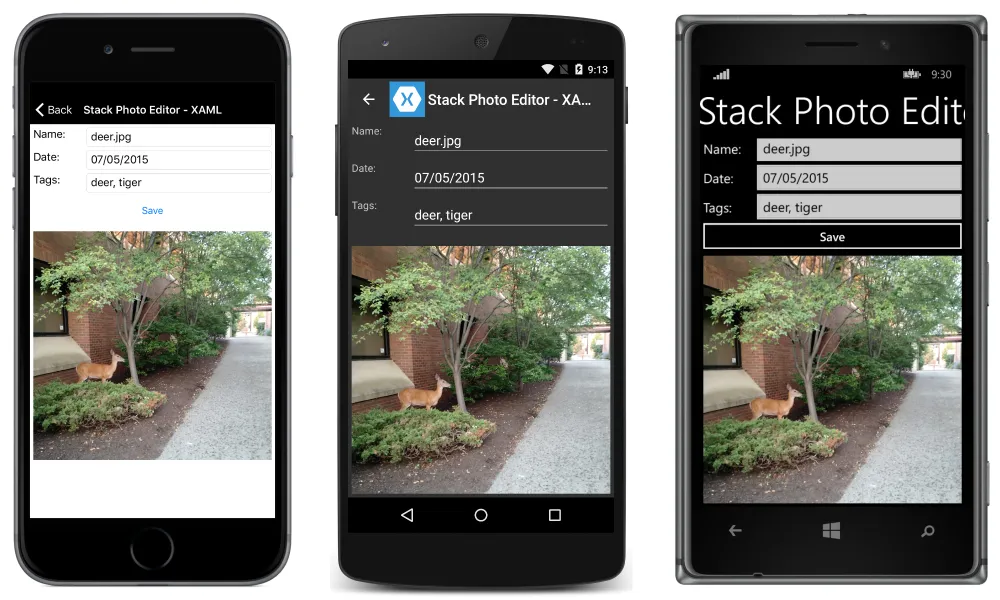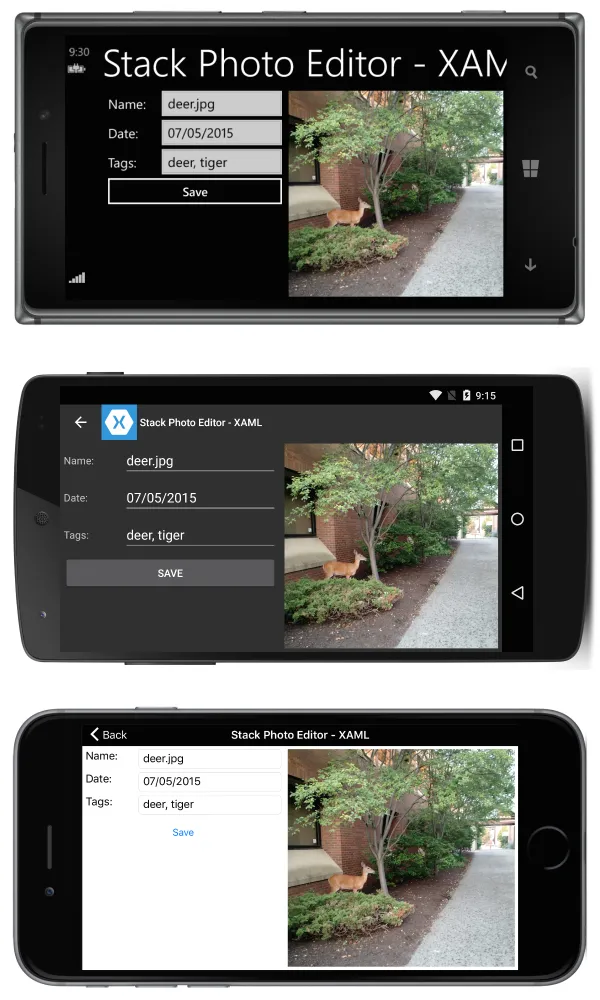Xamarin.Forms中是否已经包含一个控件/布局可以根据屏幕方向或大小对其内容进行排序?
我的要求: 如果屏幕有足够的空间,应该有两个水平排列的stacklayouts。 当屏幕尺寸变化时,如果屏幕没有足够的水平空间,则应该将这两个stacklayouts垂直排列。
我不想在代码后台完成它。
我正在寻找一个只使用xaml的解决方案。
Xamarin.Forms中是否已经包含一个控件/布局可以根据屏幕方向或大小对其内容进行排序?
我的要求: 如果屏幕有足够的空间,应该有两个水平排列的stacklayouts。 当屏幕尺寸变化时,如果屏幕没有足够的水平空间,则应该将这两个stacklayouts垂直排列。
我不想在代码后台完成它。
我正在寻找一个只使用xaml的解决方案。
 横屏模式下的屏幕:
横屏模式下的屏幕:

以下是实现此操作的XAML:
<?xml version="1.0" encoding="UTF-8"?>
<ContentPage xmlns="http://xamarin.com/schemas/2014/forms"
xmlns:x="http://schemas.microsoft.com/winfx/2009/xaml"
x:Class="ResponsiveLayout.StackLayoutPageXaml"
Title="Stack Photo Editor - XAML">
<ContentPage.Content>
<StackLayout Spacing="10" Padding="5" Orientation="Vertical"
x:Name="outerStack"> <!-- can change orientation to make responsive -->
<ScrollView>
<StackLayout Spacing="5" HorizontalOptions="FillAndExpand"
WidthRequest="1000">
<StackLayout Orientation="Horizontal">
<Label Text="Name: " WidthRequest="75"
HorizontalOptions="Start" />
<Entry Text="deer.jpg"
HorizontalOptions="FillAndExpand" />
</StackLayout>
<StackLayout Orientation="Horizontal">
<Label Text="Date: " WidthRequest="75"
HorizontalOptions="Start" />
<Entry Text="07/05/2015"
HorizontalOptions="FillAndExpand" />
</StackLayout>
<StackLayout Orientation="Horizontal">
<Label Text="Tags:" WidthRequest="75"
HorizontalOptions="Start" />
<Entry Text="deer, tiger"
HorizontalOptions="FillAndExpand" />
</StackLayout>
<StackLayout Orientation="Horizontal">
<Button Text="Save" HorizontalOptions="FillAndExpand" />
</StackLayout>
</StackLayout>
</ScrollView>
<Image Source="deer.jpg" />
</StackLayout>
</ContentPage.Content>
</ContentPage>
protected override void OnSizeAllocated (double width, double height){
base.OnSizeAllocated (width, height);
if (width != this.width || height != this.height) {
this.width = width;
this.height = height;
if (width > height) {
outerStack.Orientation = StackOrientation.Horizontal;
} else {
outerStack.Orientation = StackOrientation.Vertical;
}
}
}
我希望它能帮到你。
StackLayout中。<ContentPage xmlns="http://xamarin.com/schemas/2014/forms"
xmlns:x="http://schemas.microsoft.com/winfx/2009/xaml"
x:Class="App.Views.TestPage">
<ContentPage.Content>
<StackLayout x:Name="OuterStackLayout">
<StackLayout>
<!-- Inner stack layout 1 -->
</StackLayout>
<StackLayout>
<!-- Inner stack layout 2 -->
</StackLayout>
</StackLayout>
</ContentPage.Content>
</ContentPage>
OnSizeAllocated并根据屏幕方向设置外部OuterStackLayout.Orientation。protected override void OnSizeAllocated(double width, double height)
{
base.OnSizeAllocated(width, height);
if (SizeHasChanged(width, height)) // elided, just compare width, height with the stored values
{
StoreSize(width, height); // store in private members
if (IsLandscape)
{
this.OuterStackLayout.Orientation = StackOrientation.Horizontal;
}
else
{
this.OuterStackLayout.Orientation = StackOrientation.Vertical;
}
}
}
public bool IsLandscape => _width > _height;
StackLayout的水平选项或其他布局参数,但基本上这样做就可以了。选项#1 '方向状态' - 竖屏和横屏。在可视状态管理器中使用'OrientationStates',如下所示:
在.XAML文件中
<Grid x:Name="myGrid"
Margin="10,30,10,10">
<VisualStateManager.VisualStateGroups>
<VisualStateGroup x:Name="OrientationStates">
<!-- Row & Column Definitions of Grid - [2 Rows, 1 Col = Portrait] & [1 Row, 2 Cols = Landscape] -->
<VisualState x:Name="Portrait">
<VisualState.Setters>
<Setter Property="Grid.RowDefinitions"
Value="*,*" />
<Setter Property="Grid.ColumnDefinitions"
Value="*" />
</VisualState.Setters>
</VisualState>
<VisualState x:Name="Landscape">
<VisualState.Setters>
<Setter Property="Grid.RowDefinitions"
Value="*" />
<Setter Property="Grid.ColumnDefinitions"
Value="*,*" />
</VisualState.Setters>
</VisualState>
</VisualStateGroup>
</VisualStateManager.VisualStateGroups>
<!-- Change position of stack layouts in grid, to match above stated orientation requirement -->
<StackLayout x:Name="firstStackLayout">
<Entry Placeholder="Enter first words" />
<Button Text="Nothing Happens" />
<VisualStateManager.VisualStateGroups>
<VisualStateGroup>
<VisualState x:Name="Portrait">
<VisualState.Setters>
<Setter Property="Grid.Row" Value="0" />
<Setter Property="Grid.Column" Value="0" />
</VisualState.Setters>
</VisualState>
<VisualState x:Name="Landscape">
<VisualState.Setters>
<Setter Property="Grid.Row" Value="0" />
<Setter Property="Grid.Column" Value="0" />
</VisualState.Setters>
</VisualState>
</VisualStateGroup>
</VisualStateManager.VisualStateGroups>
</StackLayout>
<StackLayout x:Name="secondStackLayout">
<Entry Placeholder="Enter last words" />
<Button Text="Still Nothing Happens" />
<VisualStateManager.VisualStateGroups>
<VisualStateGroup>
<VisualState x:Name="Portrait">
<VisualState.Setters>
<Setter Property="Grid.Row" Value="1" />
<Setter Property="Grid.Column" Value="0" />
</VisualState.Setters>
</VisualState>
<VisualState x:Name="Landscape">
<VisualState.Setters>
<Setter Property="Grid.Row" Value="0" />
<Setter Property="Grid.Column" Value="1" />
</VisualState.Setters>
</VisualState>
</VisualStateGroup>
</VisualStateManager.VisualStateGroups>
</StackLayout>
</Grid>
在 CodeBehind 中添加 'OnSizeAllocated()' 函数,如下所示:
在 .XAML.CS 文件中
public partial class RegisterPage : ContentPage
{
public RegisterPage()
{
InitializeComponent();
}
protected override void OnSizeAllocated(double width, double height)
{
base.OnSizeAllocated(width, height);
var state = (width > height) ? "Landscape" : "Portrait";
// Call the 'Portrait' & 'Landscape' States in .XAML File
VisualStateManager.GoToState(myGrid, state);
VisualStateManager.GoToState(firstStackLayout, state);
VisualStateManager.GoToState(secondStackLayout, state);
}
}
[或者]
选项 #2 魔法子弹 - 您的唯一 .XAML 文件解决方案。
'方向触发器' - 竖屏和横屏。
在可视状态中使用 '状态触发器' 中的 '方向状态触发器',如下所示:
在 .XAML 文件内部
<Grid Margin="10,30,10,10">
<VisualStateManager.VisualStateGroups>
<VisualStateGroup>
<!-- Row & Column Definitions of Grid - [2 Rows, 1 Col = Portrait] & [1 Row, 2 Cols = Landscape] -->
<VisualState x:Name="gridPortrait">
<VisualState.StateTriggers>
<OrientationStateTrigger Orientation="Portrait" />
</VisualState.StateTriggers>
<VisualState.Setters>
<Setter Property="Grid.RowDefinitions"
Value="*,*" />
<Setter Property="Grid.ColumnDefinitions" Value="*" />
</VisualState.Setters>
</VisualState>
<VisualState x:Name="gridLandscape">
<VisualState.StateTriggers>
<OrientationStateTrigger Orientation="Landscape" />
</VisualState.StateTriggers>
<VisualState.Setters>
<Setter Property="Grid.RowDefinitions"
Value="*" />
<Setter Property="Grid.ColumnDefinitions"
Value="*,*" />
</VisualState.Setters>
</VisualState>
</VisualStateGroup>
</VisualStateManager.VisualStateGroups>
<!-- Change position of stack layouts in grid, to match above stated orientation requirement -->
<StackLayout>
<Entry Placeholder="Enter first words" />
<Button Text="Nothing Happens" />
<VisualStateManager.VisualStateGroups>
<VisualStateGroup>
<VisualState x:Name="myPortraitState">
<VisualState.StateTriggers>
<OrientationStateTrigger Orientation="Portrait" />
</VisualState.StateTriggers>
<VisualState.Setters>
<Setter Property="Grid.Row" Value="0" />
<Setter Property="Grid.Column" Value="0" />
</VisualState.Setters>
</VisualState>
<VisualState x:Name="myLandscapeState">
<VisualState.StateTriggers>
<OrientationStateTrigger Orientation="Landscape" />
</VisualState.StateTriggers>
<VisualState.Setters>
<Setter Property="Grid.Row" Value="0" />
<Setter Property="Grid.Column" Value="0" />
</VisualState.Setters>
</VisualState>
</VisualStateGroup>
</VisualStateManager.VisualStateGroups>
</StackLayout>
<StackLayout>
<Entry Placeholder="Enter last words" />
<Button Text="Still Nothing Happens" />
<VisualStateManager.VisualStateGroups>
<VisualStateGroup>
<VisualState x:Name="myPortraitState">
<VisualState.StateTriggers>
<OrientationStateTrigger Orientation="Portrait" />
</VisualState.StateTriggers>
<VisualState.Setters>
<Setter Property="Grid.Row" Value="1" />
<Setter Property="Grid.Column" Value="0" />
</VisualState.Setters>
</VisualState>
<VisualState x:Name="myLandscapeState">
<VisualState.StateTriggers>
<OrientationStateTrigger Orientation="Landscape" />
</VisualState.StateTriggers>
<VisualState.Setters>
<Setter Property="Grid.Row" Value="0" />
<Setter Property="Grid.Column" Value="1" />
</VisualState.Setters>
</VisualState>
</VisualStateGroup>
</VisualStateManager.VisualStateGroups>
</StackLayout>
</Grid>
Xamarin.Essentials 是一个更简单的解决方案。
Model.cs
using Xamarin.Essentials;
.
.
.
private DisplayOrientation orientation = DeviceDisplay.MainDisplayInfo.Orientation;
public DisplayOrientation Orientation
{
get => orientation;
set => orientation = value;
}
View.xaml.cs
using Xamarin.Essentials;
.
.
.
protected override void OnSizeAllocated(double width, double height)
{
base.OnSizeAllocated(width, height);
model.Orientation = DeviceDisplay.MainDisplayInfo.Orientation;
}
View.xaml
<ContentPage xmlns:ess="clr-namespace:Xamarin.Essentials;assembly=Xamarin.Essentials">
<ContentPage.BindingContext>
<!--Model here-->
</ContentPage.BindingContext>
<DataTrigger TargetType="..."
Binding="{Binding Orientation}"
Value="{x:Static ess:DisplayOrientation.Portrait}">
<Setter Property="..." Value="..." />
</DataTrigger>
<DataTrigger TargetType="..."
Binding="{Binding Orientation}"
Value="{x:Static ess:DisplayOrientation.Landscape}">
<Setter Property="..." Value="..." />
</DataTrigger>
</ContentPage>
不要忘记 INotifyPropertyChanged 的影响。